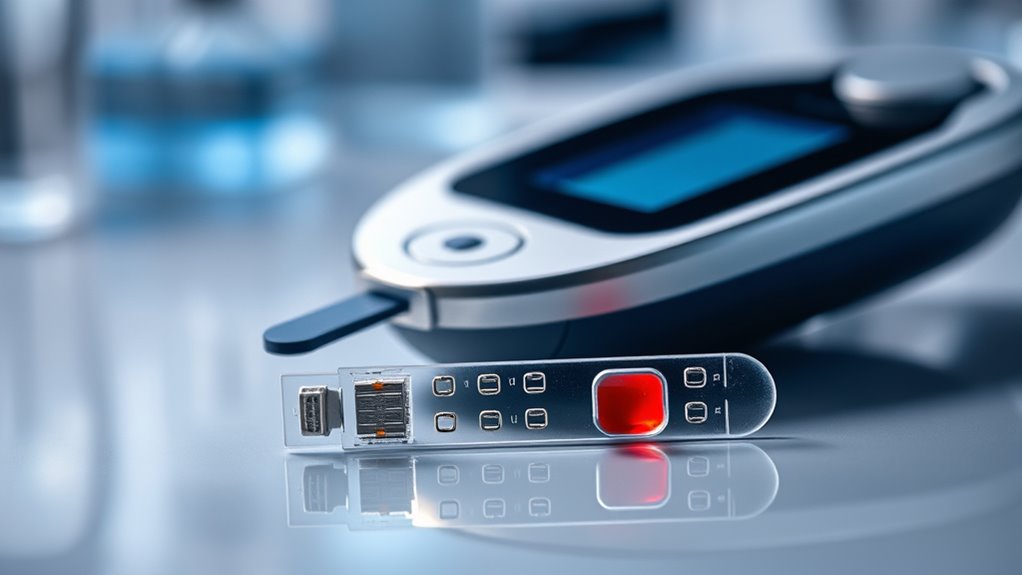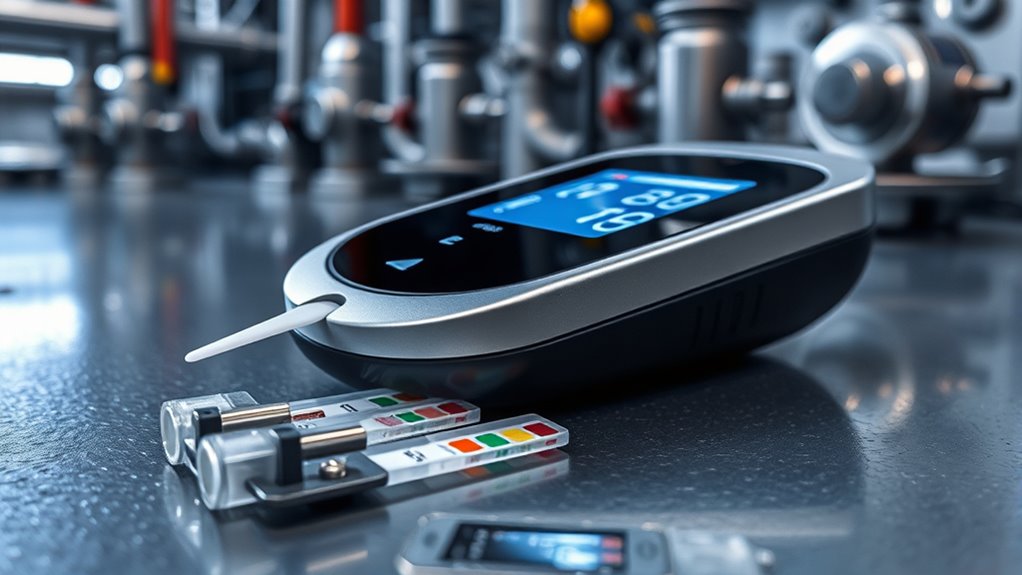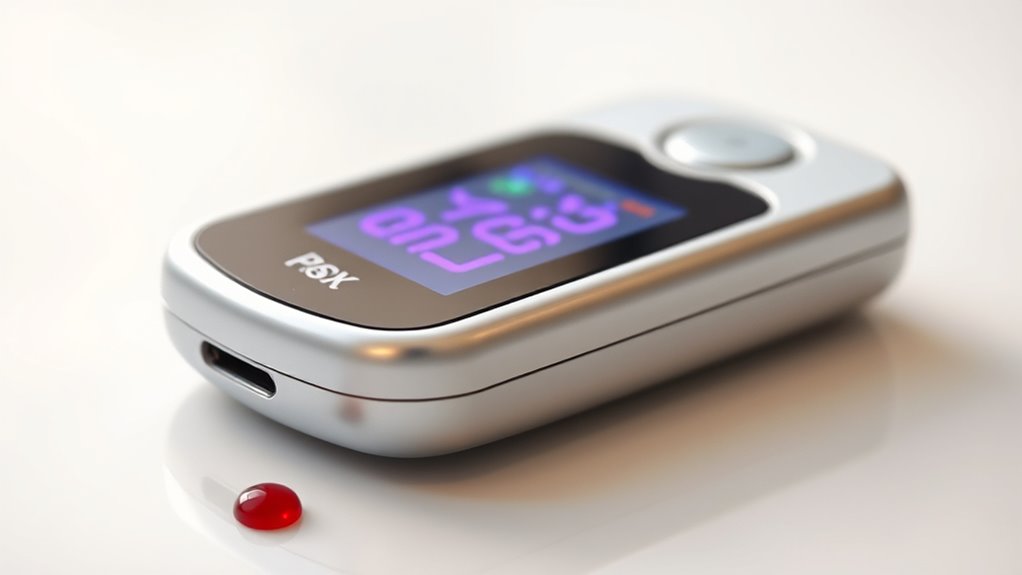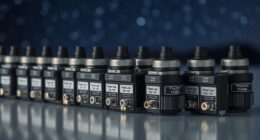Electrochemical sensors, like glucose meters, detect analytes by converting chemical reactions into electrical signals, offering quick, accurate results. They play a key role in blood glucose monitoring through enzymatic biosensors, and their capabilities extend to healthcare for detecting various biomarkers, as well as environmental monitoring for pollutants. Advances in nanomaterials and miniaturization are pushing these sensors toward wearable, real-time devices. Explore further to discover how these innovations are transforming health and environmental care.
Key Takeaways
- Electrochemical sensors convert chemical interactions into electrical signals, enabling precise detection of analytes like glucose.
- Glucose meters utilize enzymatic biosensors, primarily glucose oxidase, for accurate blood glucose monitoring.
- These sensors are expanding into healthcare for diagnosing various conditions and supporting real-time, point-of-care testing.
- Environmental monitoring benefits from portable electrochemical sensors that detect pollutants and contaminants with high sensitivity.
- Future innovations include wearable, flexible devices integrated with IoT and nanomaterials for continuous health tracking.
Fundamentals of Electrochemical Sensing Technologies

Electrochemical sensing technologies are based on the interaction between an analyte and a sensor component that produces an electrical signal. In these sensors, a receptor binds the analyte, while the electrode acts as the transducer, converting the chemical interaction into an electrical response. When the analyte undergoes oxidation or reduction at the electrode surface, it generates a current proportional to its concentration. This electrical signal is measured and analyzed to determine the analyte’s properties. This fundamental process underpins various electrochemical sensing methods, allowing for real-time, sensitive, and often in situ analysis in diverse applications. Proper storage of electrodes is essential to maintain their accuracy and prolong their lifespan. Developing robust electrode materials enhances sensor durability and reliability in various environments. Additionally, advancements in nanomaterials have contributed to increased sensitivity and selectivity in electrochemical sensors.
Role of Enzymatic Biosensors in Blood Glucose Monitoring

Enzymatic biosensors play a crucial role in blood glucose monitoring by providing rapid, accurate, and specific measurements essential for diabetes management. They typically use glucose oxidase (GOD) to recognize glucose, triggering an electrochemical reaction that converts glucose into gluconic acid and hydrogen peroxide. This reaction generates an electric current or potential difference, which correlates directly with glucose levels. Their high sensitivity and specificity make them reliable tools for point-of-care blood glucose meters and continuous monitoring systems. They are also often designed with beneficial ingredients like collagen and hyaluronic acid to improve performance and stability. These biosensors are valued for their simplicity, cost-effectiveness, and quick results, making them accessible for both clinical and home use. Additionally, ongoing advancements in biosensor technology aim to enhance their stability and reduce enzyme degradation, ensuring longer-lasting and more reliable measurements. The integration of wearable devices is also expanding the scope of blood glucose monitoring, providing real-time data to users. Despite some limitations like stability and enzyme degradation, their established technology continues to be a cornerstone in effective diabetes management.
Expanding Healthcare Applications of Electrochemical Sensors

The expanding applications of electrochemical sensors are transforming healthcare by enabling earlier and more accurate diagnoses across a wide range of conditions. You can now detect diseases early with highly sensitive biosensors that measure biomarkers like DNA, antigens, and cancer markers.
These sensors assist in diagnosing heart conditions through real-time health monitoring. They’re designed for point-of-care testing, making health assessments faster, affordable, and non-invasive. Common causes of sensor failure can be mitigated through proper calibration and maintenance, ensuring consistent performance.
Integrated into compact devices, they facilitate continuous monitoring of critical signs, especially with wearable technology that offers real-time data and improved patient care. Inspirational quotes about fatherhood often emphasize the importance of support and guidance, paralleling how these sensors provide critical insights for health management.
Beyond glucose, electrochemical sensors now measure cholesterol, lactate, urea, and creatinine, expanding diagnostic options. Their small size, low power needs, and high accuracy make them essential tools for advancing personalized medicine and improving health outcomes. Sustainable weight loss strategies also contribute to better overall health and the effectiveness of these innovative diagnostic tools.
Environmental and Industrial Monitoring With Electrochemical Devices

Advances in miniaturization and microfabrication have revolutionized environmental and industrial monitoring by enabling the development of highly sensitive and portable electrochemical sensors. These sensors deliver improved detection limits, allowing you to measure pollutants accurately right in the field. Vetted Microfabrication techniques make them more durable and lightweight, perfect for on-site use. They’re also cost-effective and provide rapid results compared to traditional lab methods. Many include remote communication features, so you can monitor data in real time without physically accessing the device. You can detect a wide range of pollutants, including heavy metals and organic contaminants, directly at their source. These sensors support sustainable practices by enabling quick, reliable assessments of air and water quality, helping you ensure environmental safety and regulatory compliance efficiently.
Future Trends and Innovations in Sensor Development

Miniaturization and integration of electrochemical sensors into wearable devices are transforming personal health monitoring. You can now enjoy continuous, real-time tracking with compact, flexible sensors that conform to your body, enhancing comfort and usability.
Low-power electronics extend battery life and enable wireless data transmission, making monitoring seamless.
Advanced materials, like nanostrstructured electrodes, boost sensitivity and durability, while self-healing and transparent designs improve longevity and aesthetics.
Integration with IoT platforms allows your devices to send data remotely to smartphones or cloud systems, supporting AI-driven diagnostics and personalized treatments.
These innovations make health monitoring more accessible, accurate, and user-friendly, paving the way for smarter, more autonomous wearable sensors that adapt to your daily needs and improve overall well-being.
Frequently Asked Questions
How Do Electrochemical Sensors Compare to Optical Sensing Methods?
You see that electrochemical sensors rely on chemical reactions at electrodes, offering high accuracy and cost-effectiveness, especially in portable and harsh environments.
Optical sensors use light to measure changes, providing fast responses, high precision, and stability, often in laboratory or remote settings.
While electrochemical sensors are prone to interference and require maintenance, optical sensors are less affected by environmental factors and need less upkeep.
What Are the Main Challenges in Developing Multiplexed Biosensors?
You face many challenges in developing multiplexed biosensors. While they promise simultaneous detection of multiple targets, ensuring high sensitivity and specificity without cross-reactivity is tough.
You also need sophisticated, automated instrumentation that’s complex and costly, making at-home use difficult.
Designing stable, reliable sensors that avoid cross-reactions, adapt quickly to new targets, and remain affordable adds to the complexity.
Balancing performance, cost, and user-friendliness remains a significant hurdle.
How Does Temperature Affect Electrochemical Sensor Accuracy?
You should know that temperature directly influences electrochemical sensor accuracy by affecting reaction rates, sensitivity, and material stability.
When temperatures are too high or low, sensors may give unreliable readings due to electrolyte evaporation, slow responses, or material degradation.
To maintain accuracy, you need to implement temperature compensation strategies, such as hardware adjustments or software algorithms, ensuring your sensors work reliably across varying environmental conditions.
What Are the Limitations of Current Wearable Glucose Sensors?
Like a fragile glass, current wearable glucose sensors face many limitations. You might experience skin irritation or adhesion issues, making wear uncomfortable and unreliable.
Accuracy can suffer from environmental factors or sensor failures, and calibration adds burdens.
Battery life is limited, and frequent replacements cost money.
Accessibility and high prices hinder widespread use, while data overload and false alarms can cause frustration.
These challenges affect your consistent and effective glucose monitoring.
How Can Sensor Fouling Be Minimized in Long-Term Applications?
To minimize sensor fouling long-term, you should implement protective barrier layers like PEG or superhydrophobic coatings that prevent contaminants from reaching the surface.
Alter the surface chemistry to repel fouling agents, use active strategies like enzymatic coatings or catalytic layers to break down biofouling, and incorporate periodic cleaning cycles or easy surface renewal.
These approaches help maintain sensor accuracy and extend its operational lifespan effectively.
Conclusion
As you explore electrochemical sensors, remember they’re more than just glucose meters—they’re the future of precise, versatile monitoring. With innovations on the horizon, these devices will transform healthcare, environmental, and industrial fields. Imagine a world where sensing technology seamlessly integrates into your life, like a silent guardian. Embrace these advancements, for they’re not just tools, but gateways to a healthier, safer future—turning science fiction into reality before your very eyes.









